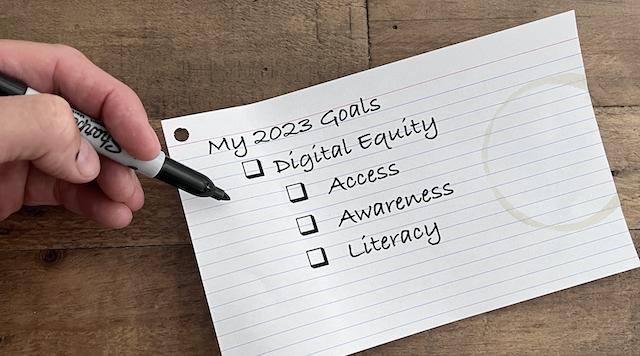Digital Equity Solutions Require Nuance

The CHALLENGE
According to the Pew Research Center, only 1% of the US population had a broadband connection at home at the start of the 21st Century. Roughly three-quarters of Americans connect to high-speed Internet from home today. Progress? You bet. Good enough? Absolutely not. Those unable, unaware, or unwilling to go online from home are at a high risk of being excluded from economic opportunity, access to essential services, educational advancement, cultural/social connections, and much more.
A deeper dive into the data reveals income is a significant factor distinguishing households with Internet access from those without. Just over half (57%) of households with less than $30,000 per year accessed the Internet from where they live in 2021. This compares with more than 90% of households categorized as over $75,000 per year reporting a home broadband connection. It is tempting to conclude that affordability is the primary barrier to purchasing a service and device required to access broadband at home. However, the issue is much more nuanced and complex. Examples of other factors which can be equally or even greater barriers to on-line participation include:
- Perceived Value: Family background, culture, religious tenets, or age all can impact the perceived value of purchasing equipment and services necessary to access the Internet.
- Unique Circumstances: Those with limited English language skills and those with disabilities often face specific barriers in accessing digital devices, as well as barriers in accessing supportive services, and programs to help them go on-line.
- Service Availability: In some rural areas and urban neighborhoods high-speed Internet service is simply unavailable or of low quality.
- Digital Literacy: For a variety of reasons (associated with age, educational attainment, culture, etc.) some households find digital know-how a major barrier to going on-line.
The primary challenge is that there are multiple specific individual and community barriers to on-line access, adoption and use. Addressing only the barriers of affordability and availability is unlikely to be enough by itself to deliver the benefits of digital access for many historically unconnected populations.
The SOLUTION
As noted in several recent Futures Research blog posts, a number of states are in the process of developing statewide digital equity plans. The communities and individuals presently not on-line are different in each state. Consequently, no two states will have the same plan. Each state is tasked with creating a robust action plan that reflects an understanding of the nuanced circumstances creating barriers to on-line participation for a multitude of different types of unconnected communities present in each state. Several considerations are especially important to shape such a nuanced digital equity plan.
- Flexible Engagement: A “one-size-fits all” approach is unlikely to be successful in engaging participation from all the different unconnected communities. For example, regional listening sessions may work well in one neighborhood, region of the state or with specific communities, but be unsuccessful in a different part of the state where there are more transportation challenges, Internet access limitations, or cultural barriers to participation. To be successful, state leadership must implement a flexible engagement approach guided with a contextual understanding of how to most effectively reach different types of stakeholder groups.
- Granular Data: Successful plans are grounded with accurate quantitative and qualitative data necessary to understand gaps in Internet access, adoption and application at a granular level. In recent years both federal and state leadership have prioritized the development of more accurate and geographically granular broadband maps showing where there are service gaps. New frontiers include developing equally geographically granular mapping of broadband adoption and application. Qualitative data collected from stakeholders at a local level can help provide context to interpret these data to inform the creation of a statewide digital equity plan.
- Future Foresight: In 2016, 17% of young adults (ages 18 - 29) reported they owned a smart-phone, but did not have a traditional broadband connection at home. By 2021, 28% of young adults fell into this category. Observations such as this raise the question of what the future for digital access will be as technology and demographics change. In the development of a digital equity action plan, state leadership must assemble the best information possible to anticipate changes in technology, consumer preferences and demographics and consider how those changes may impact the success of the plan.
Achieving statewide digital equity is a complex challenge. Partnering with stakeholders who are as close to the ground as possible, can be an important step in gaining the localized engagement, data and foresight necessary to discover the nuances which can frame meaningful solutions leading to improvements in digital equity.
Prepared for Futures Research by Bill Gillis, Spokane, WA